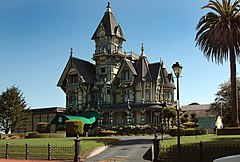Carson Mansion
| Carson Mansion | |
|---|---|

|
|
| General information | |
| Architectural style | American Style Queen Anne (Victorian) |
| Town or city |
143 M Street Eureka, California |
| Country | United States |
| Construction started | 1884 |
| Completed | 1886 |
| Cost | $80,000 |
| Client |
William Carson (co-founder and co-owner of Dolbeer & Carson Lumber Company) |
| Technical details | |
| Structural system | concrete foundation; Douglas Fir frame; Redwood exterior |
| Size | In excess of 16,200 sq ft (1,510 m2). on 3 floors (excluding basement) plus 103 feet (31 m) tower; 18 rooms |
| Design and construction | |
| Architect |
Samuel Newsom and Joseph Cather Newsom |
| Engineer | W. H. Mills (construction supervisor) |
Coordinates: 40°48′20″N 124°09′31″W / 40.80562°N 124.15848°W
143 M Street
William Carson (co-founder and co-owner of
Samuel Newsom and
The Carson Mansion is a large Victorian house located in Old Town, Eureka, California. Regarded as one of the highest executions of American Queen Anne Style architecture, the house is "considered the most grand Victorian home in America." It is one of the most written about and photographed Victorian houses in California, and perhaps, in the United States. Originally the home of William Carson, one of Northern California's first major lumber barons, since 1950 it has been a private club, The house and grounds are not open to the public.
William Carson (July 15, 1825 New Brunswick – February 20, 1912 Eureka), for whom the house was built, arrived in San Francisco from New Brunswick, Canada with a group of other woodsmen in 1849. After rolling out gold slugs in San Francisco, they joined in the northern gold rush, arriving in the Trinity Mountains via the Eel River and Humboldt Bay. They left the Trinity Mountains to overwinter at Humboldt Bay and contracted to provide logs for a small sawmill. In November 1850 Carson and Jerry Whitmore felled a tree, the first for commercial purposes on Humboldt Bay. All winter, Carson and his team hauled logs from the Freshwater slough to the Pioneer Mill on the shores of Humboldt Bay. In spring, the party went back to the mines where they had previously staked claim on Big Bar by the Trinity. They built a dam and continued mining until they heard that a large sawmill was being built at Humboldt Bay. They went south through the Sacramento Valley, bought oxen, and returned to Humboldt Bay by August 1852, where Carson, alone, went into the lumber business permanently. In 1854, he shipped the first loads of redwood timber to San Francisco. Previously, only fir and spruce had been logged.
...
Wikipedia
